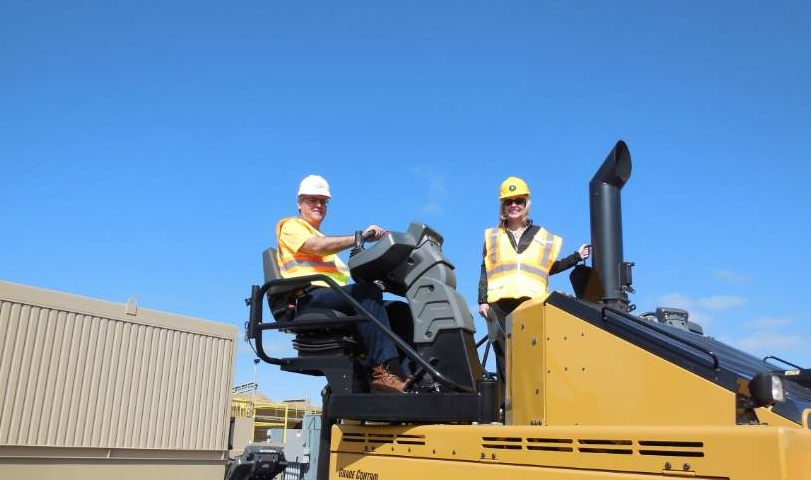Meet the State Exec: Jill M. Thomas
BY AsphaltPro Staff


MAPA Executive Director Jill Thomas takes a spin during the outdoor portion of the SAPA’s event.
We continue the introduction to state asphalt pavement association (SAPA) executive directors with Minnesota’s Jill M. Thomas, P.E. She brings a Master of Science and Bachelor of Civil Engineering from the University of Minnesota’s Institute of Technology in the Twin Cities to her post.
State Association:
Minnesota Asphalt Pavement Association (MAPA), New Brighton, Minnesota
How long have you been in the asphalt industry?
19 years
How long have you been the executive director of your state association?
2 ½ years
In what year was your state association formed?
1953
How many producer and/or contractor members are in your state association?
32 contractor members (about 90%)
What are the top two or three ways you have increased membership in the association?
Our Board members have made membership a number one priority and have increased our membership accordingly.
What is your favorite method for recruiting new asphalt professionals to the industry in general?
Visiting and talking with young professionals at university colleges and technical colleges.
In what month do you hold your annual meeting?
December
Do you have a trade show/expo in addition to your annual meeting?
No, but we have exhibitors at our spring workshop.
Do you have a staff that assists in preparing the annual meeting?
We have a staff of three total and we all work as a team on the annual meeting.
Does your office/staff hold educational seminars or webinars for members separate from the annual meeting/convention(s) throughout the year?
Yes
About how many member asphalt projects do you visit per year/paving season?
Approx. 10-20
About how many member asphalt plant tours do you assist/are you a part of per year?
Approx. 5
About how many member asphalt open house events do you attend per year?
Approx. 5
About how many state agency or DOT meetings do you attend per year?
Almost weekly with different topics
On a scale of 1 to 5 (1 being none at all; 5 being very much), how much of a threat to your members’ marketshare/livelihood is the concrete industry in your state?
5, they are very aggressive in Minnesota
Could you share an example of a time when the concrete industry encroached on the asphalt marketplace in your state?
Asphalt was chosen to overlay a major interstate and the Portland Cement Association was so upset that they paid for billboards around Minnesota that ridiculed asphalt and the DOT. They did not win any arguments this way and lost relationships.
On a scale of 1 to 5 (1 being none at all; 5 being very much), how much difficulty are your members having in finding qualified workers for their asphalt paving or production crews?
5, this is a huge issue in Minnesota
Could you give an example of a way your state APA assists members with workforce development?
We assist with employer open houses and we visit technical schools to promote the industry.
On a scale of 1 to 5 (1 being none at all; 5 being very much), how involved are your state elected officials in transportation issues such as funding and infrastructure improvements?
4, though they tend to let DOT make the engineering decisions.
On a scale of 1 to 5 (1 being none at all; 5 being very much), how involved are your asphalt members in transportation issues such as funding and infrastructure improvements?
3, half are involved heavily
Could you share an example of a time when your state APA hosted elected officials to educate them on the need for highway funding OR asphalt materials OR construction work force development, etc.?
This year we are hosting two meet-and-greets in Minnesota with local government and elected officials invited. They are very successful and we have done four to six each year.

Jill M. Thomas, P.E.
Get to Know Jill Thomas
Why (or how) did you join the asphalt industry?
While attending the University of Minnesota, I was working for Prof. David Newcomb in the asphalt pavement laboratory. When I was nearing graduation, Dave asked me if I would like to stay and work to get my Masters Degree on a project at the Minnesota Road Research (MnROAD) facility. I gladly stayed and have been in the asphalt industry ever since.
What do you see as the most important part of your job as an executive director of a SAPA?
Maintaining relationships between my members and agencies/owners/specifiers for the best outcome for tax payers.
What is the most challenging part of your job?
We are heavily targeted in Minnesota by the Concrete Pavers of Minnesota, Aggregate Ready Mix Assoc. of Minnesota, the Portland Cement Association, and the Concrete Sustainability Hub at MIT in efforts to gain on market share. We have fewer staff and resources in comparison to the concrete industry; however, we have been very successful in slowing and preventing their efforts from succeeding.
What do you find most enjoyable about your job as an executive director of a SAPA?
I find having a dynamic association that changes with the members’ needs is challenging and fulfilling. It is difficult to try new things, but an open mind is crucial to keeping the association relevant and current.
